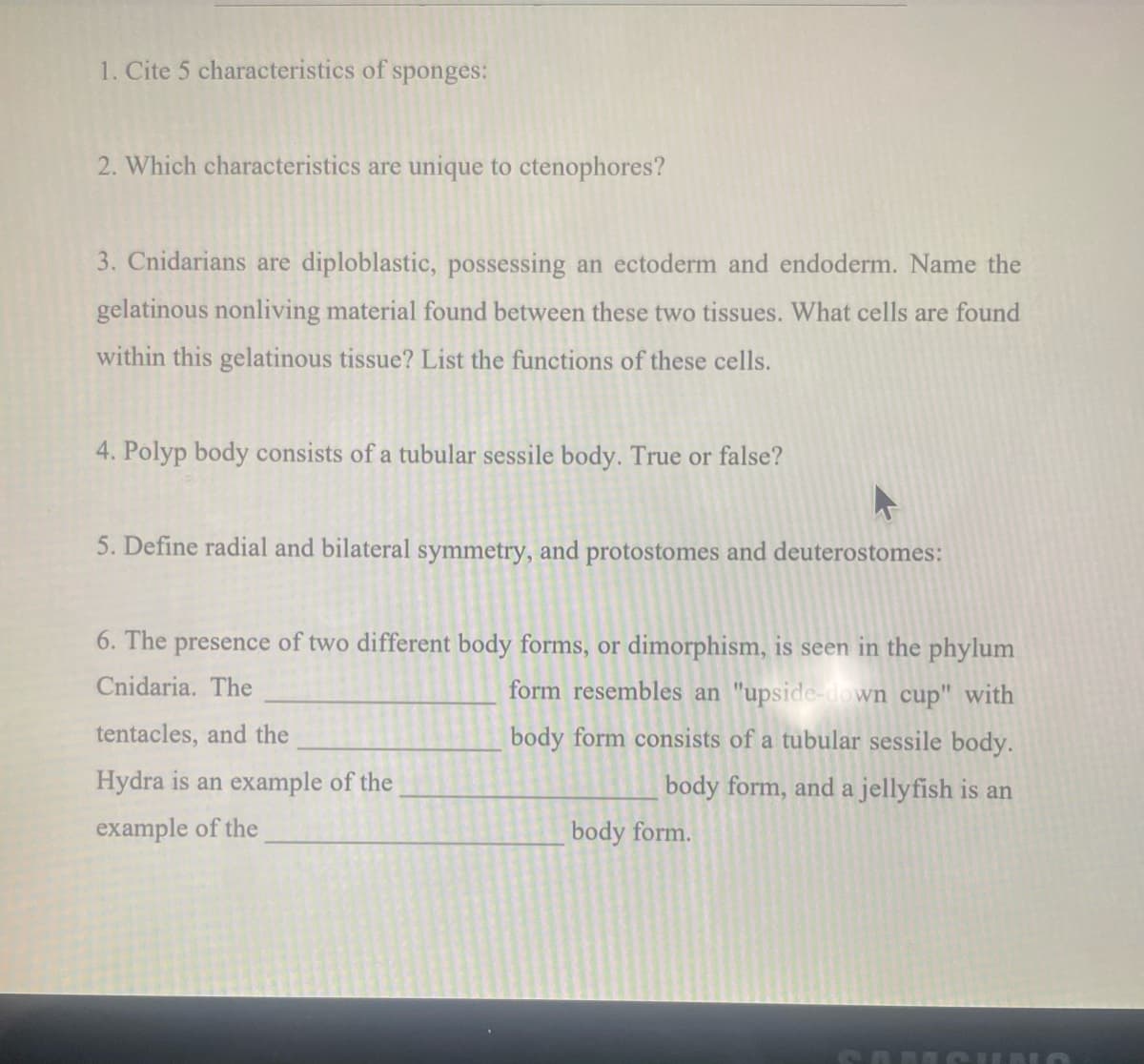1. Cite 5 characteristics of sponges: 2. Which characteristics are unique to ctenophores? 3. Cnidarians are diploblastic, possessing an ectoderm and endoderm. Name the gelatinous nonliving material found between these two tissues. What cells are found within this gelatinous tissue? List the functions of these cells. 4. Polyp body consists of a tubular sessile body. True or false? 5. Define radial and bilateral symmetry, and protostomes and deuterostomes:
1. Cite 5 characteristics of sponges: 2. Which characteristics are unique to ctenophores? 3. Cnidarians are diploblastic, possessing an ectoderm and endoderm. Name the gelatinous nonliving material found between these two tissues. What cells are found within this gelatinous tissue? List the functions of these cells. 4. Polyp body consists of a tubular sessile body. True or false? 5. Define radial and bilateral symmetry, and protostomes and deuterostomes:
Biology 2e
2nd Edition
ISBN:9781947172517
Author:Matthew Douglas, Jung Choi, Mary Ann Clark
Publisher:Matthew Douglas, Jung Choi, Mary Ann Clark
Chapter28: Invertebrates
Section: Chapter Questions
Problem 6RQ: Most sponge body plans are slight variations on a simple tube-within-a-tube design. Which of the...
Related questions
Question

Transcribed Image Text:1. Cite 5 characteristics of sponges:
2. Which characteristics are unique to ctenophores?
3. Cnidarians are diploblastic, possessing an ectoderm and endoderm. Name the
gelatinous nonliving material found between these two tissues. What cells are found
within this gelatinous tissue? List the functions of these cells.
4. Polyp body consists of a tubular sessile body. True or false?
5. Define radial and bilateral symmetry, and protostomes and deuterostomes:
6. The presence of two different body forms, or dimorphism, is seen in the phylum
Cnidaria. The
form resembles an "upside-down cup" with
tentacles, and the
body form consists of a tubular sessile body.
Hydra is an example of the
body form, and a jellyfish is an
example of the
pody form.
Expert Solution
This question has been solved!
Explore an expertly crafted, step-by-step solution for a thorough understanding of key concepts.
This is a popular solution!
Trending now
This is a popular solution!
Step by step
Solved in 6 steps

Knowledge Booster
Learn more about
Need a deep-dive on the concept behind this application? Look no further. Learn more about this topic, biology and related others by exploring similar questions and additional content below.Recommended textbooks for you

Biology 2e
Biology
ISBN:
9781947172517
Author:
Matthew Douglas, Jung Choi, Mary Ann Clark
Publisher:
OpenStax

Biology (MindTap Course List)
Biology
ISBN:
9781337392938
Author:
Eldra Solomon, Charles Martin, Diana W. Martin, Linda R. Berg
Publisher:
Cengage Learning

Biology: The Dynamic Science (MindTap Course List)
Biology
ISBN:
9781305389892
Author:
Peter J. Russell, Paul E. Hertz, Beverly McMillan
Publisher:
Cengage Learning

Biology 2e
Biology
ISBN:
9781947172517
Author:
Matthew Douglas, Jung Choi, Mary Ann Clark
Publisher:
OpenStax

Biology (MindTap Course List)
Biology
ISBN:
9781337392938
Author:
Eldra Solomon, Charles Martin, Diana W. Martin, Linda R. Berg
Publisher:
Cengage Learning

Biology: The Dynamic Science (MindTap Course List)
Biology
ISBN:
9781305389892
Author:
Peter J. Russell, Paul E. Hertz, Beverly McMillan
Publisher:
Cengage Learning

Concepts of Biology
Biology
ISBN:
9781938168116
Author:
Samantha Fowler, Rebecca Roush, James Wise
Publisher:
OpenStax College
